The wounded came in waves. First in ones and twos, limping up the steps and staggering through the aluminum doors, and then in wheelbarrows, with bleeding skulls and stabbed necks. Finally, the motorcycles and auto-rickshaws arrived, their seats stained with the blood of as many as they could hold.
As the Mustafabad neighborhood of India's capital was ravaged by communal riots for three days this week, the Al-Hind Hospital turned from a community clinic into a trauma ward.
Doctors like M.A. Anwar were for the first time dealing with injuries like gunshot wounds, crushed skulls and torn genitals.
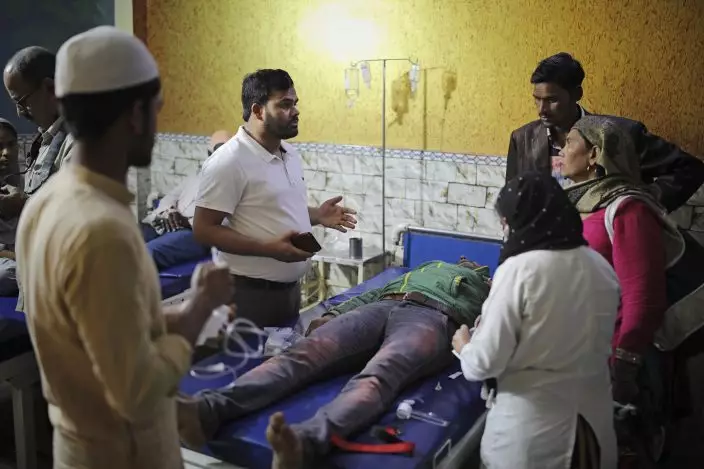
In this Friday, Feb. 28, 2020 photo, Dr. M. A. Anwar, left, speaks to family members of Mehdi Hassan, who was hit by an iron rod by rioters, as he is treated at Al-Hind hospital in Old Mustafabad neighborhood of New Delhi, India. On the eve of U.S. President Donald Trump’s first state visit to India last Sunday, Hindus and Muslims in the Indian capital charged at each other with homemade guns and crude weapons, leaving the streets where the rioting occurred resembling a war zone, with houses, shops, mosques, schools and vehicles up in flames, more than 40 dead and hundreds injured. By mid-afternoon Wednesday, Anwar and his overwhelmed colleagues at the clinic had treated more than 400 people, referring almost 100 to larger hospitals. Dozens, however, remained at the clinic in critical condition. More than 50 people rescued from the riots were given refuge inside Al-Hind hospital, aided by an army of volunteers who provided food and bedding. (AP PhotoAltaf Qadri)
“I wanted to cry and scream,” he recalled. “Something inside of me died during those three days.”
Almost a week after the clashes between Hindus and Muslims began, a clearer picture of the horrors inflicted during New Delhi's worst communal riots in decades has begun to emerge.
On the eve of U.S. President Donald Trump’s first state visit to India last Sunday, Hindus and Muslims in the Indian capital charged at each other with homemade guns and crude weapons, leaving the streets where the rioting occurred resembling a war zone, with houses, shops, mosques, schools and vehicles up in flames. At least 42 people were killed and hundreds more wounded.
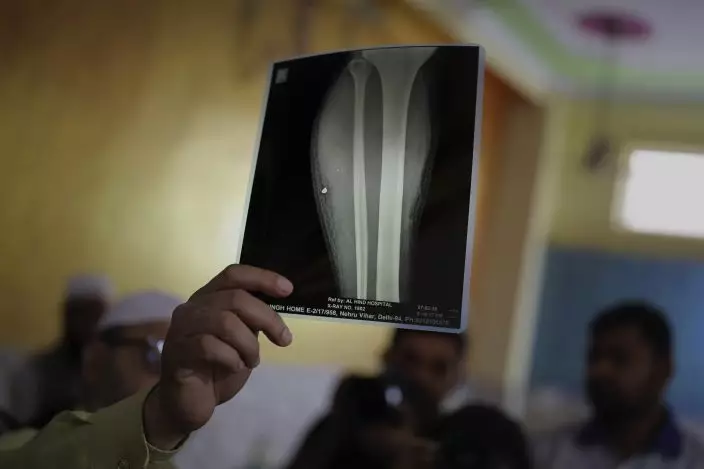
In this Friday, Feb. 28, 2020 photo, an unidentified man hold an X-Ray of a wounded man at Al-Hind hospital in Old Mustafabad neighborhood of New Delhi, India. As the Mustafabad neighborhood of India's capital broke out in brutal communal riots for three days this week, the Al-Hind Hospital turned from a community clinic into a trauma ward. Authorities haven't said what sparked the violence that has left more than 40 dead and hundreds injured, but it was the culmination of growing tensions since the passage of a citizenship law in December that fast-tracks naturalization for some religious minorities from neighboring countries but not Muslims. (AP PhotoAltaf Qadri)
Authorities have struggled to identify some of the bodies because of the gruesomeness of the injuries.
While both sides behaved brutally, most of the victims were Muslim.
Authorities haven't given an official account of what sparked the riots, though the violence appeared to be a culmination of growing tensions that followed the passage of a new citizenship law in December.
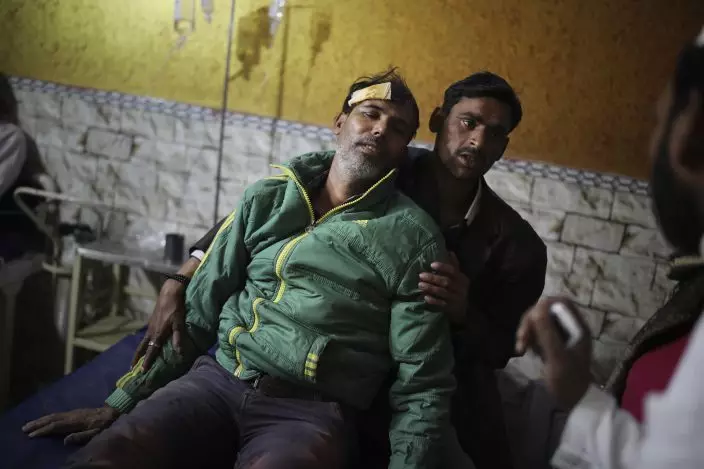
In this Friday, Feb. 28, 2020 photo, an unidentified relative supports Mehdi Hassan, who was hit by an iron rod by rioters, as he is treated at Al-Hind hospital in Old Mustafabad neighborhood of New Delhi, India.As the Mustafabad neighborhood of India's capital broke out in brutal communal riots for three days this week, the Al-Hind Hospital turned from a community clinic into a trauma ward. Authorities haven't said what sparked the violence that has left more than 40 dead and hundreds injured, but it was the culmination of growing tensions since the passage of a citizenship law in December that fast-tracks naturalization for some religious minorities from neighboring countries but not Muslims. (AP PhotoAltaf Qadri)
The law fast-tracks naturalization for some religious minorities from neighboring countries but not Muslims. Opponents say it violates India's secular constitution, and further marginalizes the 200 million Muslims in this Hindu-majority nation of 1.4 billion people.
The law spurred massive protests across India that left at least 23 dead.
But what unfolded in Mustafabad this week was far more brutal, with mobs hacking individuals with swords, burning people alive and bludgeoning people to death.
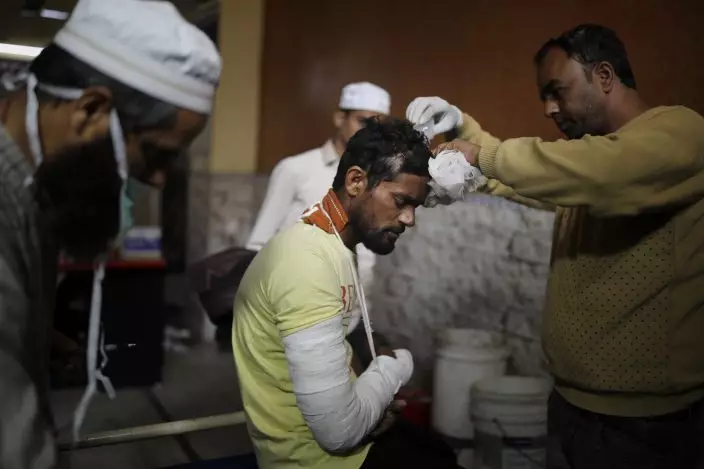
In this Friday, Feb. 28, 2020 photo, paramedics attend to the wounds of Mohammad Illyas at Al-Hind hospital in Old Mustafabad neighborhood of New Delhi, India. The hospital in the riot-torn neighborhood turned from a community clinic into a trauma ward, its doctors, for the first time, dealing with injuries like gunshot wounds, crushed skulls and torn male genitals. Authorities haven't said what sparked the violence that has left more than 40 dead and hundreds injured, but it was the culmination of growing tensions since the passage of a citizenship law in December that fast-tracks naturalization for some religious minorities from neighboring countries but not Muslims. (AP PhotoAltaf Qadri)
A Hindu intelligence bureau officer was repeatedly stabbed and his dead body thrown into a sewage drain that divides Hindu and Muslim residential areas. A Muslim man had his legs spread so far apart that the lower half of his body tore. His condition remained critical.
Questions have been raised about the role of the New Delhi police and whether they stood by while the violence raged or even aided the Hindu mobs.
A New Delhi police spokesman, Anil Mittal, denied that police had aided rioters.

In this Friday, Feb. 28, 2020 photo, a woman comforts a neighbor inside a hall at Al-Hind hospital used as a shelter for people who were rescued after they were attacked by a Hindu mob, in Old Mustafabad neighborhood of New Delhi, India. On the eve of U.S. President Donald Trump’s first state visit to India last Sunday, Hindus and Muslims in the Indian capital charged at each other with homemade guns and crude weapons, leaving the streets where the rioting occurred resembling a war zone, with houses, shops, mosques, schools and vehicles up in flames, more than 40 dead and hundreds injured. (AP PhotoAltaf Qadri)
Al-Hind hospital's doctors said authorities kept ambulances from reaching certain riot-hit places.
A little after midnight on Wednesday — more than 72 hours after the violence began — a New Delhi High Court passed an extraordinary order directing the police to provide safe passage for ambulances.
It was too late for many victims.

In this Friday, Feb. 28, 2020 photo, Muslim women, who were rescued after their homes were attacked by a marauding Hindu mob, sob while eating a meal inside a hall which doubles as a shelter at Al-Hind hospital in Old Mustafabad neighborhood of New Delhi, India. The hospital in the riot-torn neighborhood turned from a community clinic into a trauma ward, its doctors, for the first time, dealing with injuries like gunshot wounds, crushed skulls and torn male genitals. Authorities haven't said what sparked the violence that has left more than 40 dead and hundreds injured, but it was the culmination of growing tensions since the passage of a citizenship law in December that fast-tracks naturalization for some religious minorities from neighboring countries but not Muslims. (AP PhotoAltaf Qadri)
With streets taken over by the mobs and no way through for ambulances, Anwar knew early on that his clinic would soon be overcome with wounded.
Some slumped in plastic chairs as they draped gunshot-riddled arms and legs over tables.
Others just lay on the floor, bleeding.

In this Friday, Feb. 28, 2020 photo, Shabana Parveen, who delivered a baby boy on Tuesday after she was rescued by her Hindu neighbors when a Hindu mob attacked her house, rests at Al-Hind hospital in Old Mustafabad neighborhood of New Delhi, India. The hospital in the riot-torn neighborhood turned from a community clinic into a trauma ward, its doctors, for the first time, dealing with injuries like gunshot wounds, crushed skulls and torn male genitals. Authorities haven't said what sparked the violence that has left more than 40 dead and hundreds injured, but it was the culmination of growing tensions since the passage of a citizenship law in December that fast-tracks naturalization for some religious minorities from neighboring countries but not Muslims. (AP PhotoAltaf Qadri)
Those who were there described the blood and chaos, but also shared oddly uplifting stories of teamwork and grit.
“We didn’t sleep. We didn’t eat anything. All we wanted to do was save lives. And we did,” said Aanis Mohammad, a volunteer at the clinic. “No patient of any religion was turned away.”
By mid-afternoon Wednesday as the violence came to an end, Anwar and his overwhelmed colleagues had treated more than 400 people and referred almost 100 to larger hospitals. Dozens, however, remained at the clinic in critical condition.
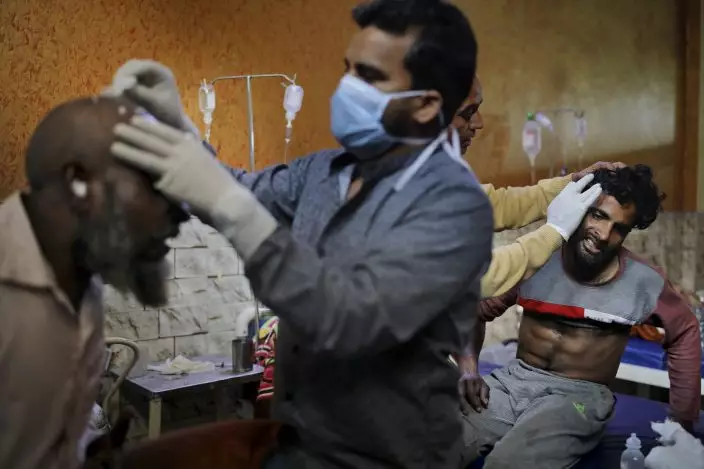
In this Friday, Feb. 28, 2020 photo, paramedics tend to the wounds of Mehfooz Umar, left, and Mohammad Afzal, right, at Al-Hind hospital in Old Mustafabad neighborhood of New Delhi, India. The hospital in the riot-torn neighborhood turned from a community clinic into a trauma ward, its doctors, for the first time, dealing with injuries like gunshot wounds, crushed skulls and torn male genitals. Questions have been raised about the role of the Delhi police, who report to Prime Minister Narendra Modi's trusted confidante, Amit Shah, and whether they stood by while the violence raged or worse, aided the Hindu mobs. Al-Hind hospital's doctors said authorities kept ambulances from reaching certain riot-hit places. (AP PhotoAltaf Qadri)
The hospital also gave refuge to those fleeing the violence, providing more than 50 people with food, bedding and safety.
Clean-up efforts in Mustafabad are underway but the scars are still visible.
At Guru Teg Bahadur hospital along New Delhi’s eastern border, 18-year-old Salman Ansari waited for his father's body to be handed over.
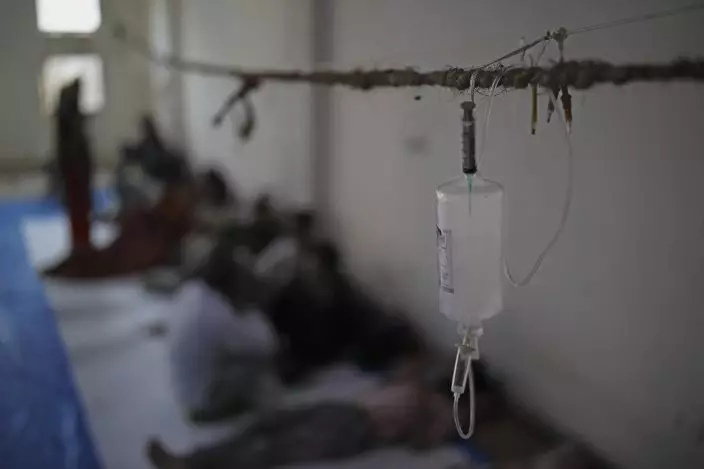
In this Friday, Feb. 28, 2020 photo, an empty saline drip hangs from a makeshift line in a hall at Al-Hind hospital used as a shelter for the people who were rescued after they were attacked by a Hindu mob, in Old Mustafabad neighborhood of New Delhi, India. The hospital in the riot-torn neighborhood turned from a community clinic into a trauma ward, its doctors, for the first time, dealing with injuries like gunshot wounds, crushed skulls and torn male genitals. Authorities haven't said what sparked the violence that has left more than 40 dead and hundreds injured, but it was the culmination of growing tensions since the passage of a citizenship law in December that fast-tracks naturalization for some religious minorities from neighboring countries but not Muslims. (AP PhotoAltaf Qadri)
Ansari's father had gone out to collect scrap for money as there was no food in the house. After seeing police assurances on the news, he thought it would be safe. It wasn't.
Ansari said he was sleeping when two strangers dumped his father outside their home early Wednesday.
He carted his father 3 kilometers (1.8 miles) on the family's rickshaw to a private clinic. The doctors demanded 5,000 rupees ($69). His pockets were empty.

An Indian Hindu man, who was allegedly injured in communal violence, addresses a protest demonstration organized by Hindu organizations in New Delhi that in New Delhi, India, Saturday, Feb. 29, 2020. On the eve of U.S. President Donald Trump’s first state visit to India last Sunday, Hindus and Muslims in the Indian capital charged at each other with homemade guns and crude weapons, leaving the streets where the rioting occurred resembling a war zone, with houses, shops, mosques, schools and vehicles up in flames. More than 40 people were killed and hundreds more wounded. (AP PhotoAltaf Qadri)
By the time Ansari managed to reach a public hospital, his father was dead.
For Anwar, the doctor, he said he eventually grew numb to the carnage. Yet he's still coming to grips with how fellow Indians could do what they did to one another.
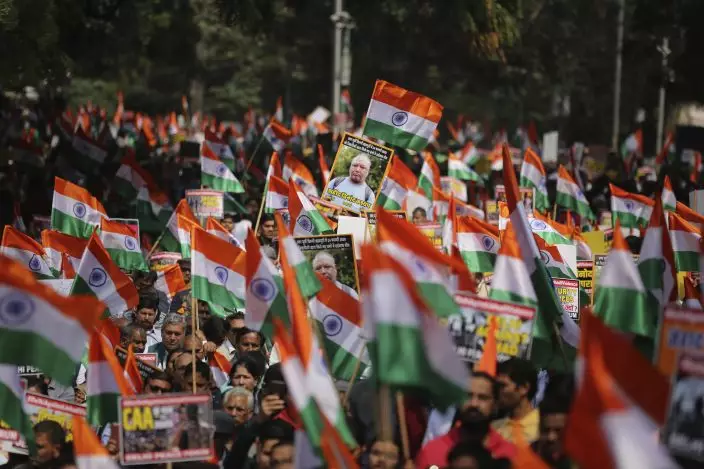
Supporters of a contentious new citizenship law wave Indian national flags as they participate in a protest demonstration organized by Hindu organizations in New Delhi that in New Delhi, India, Saturday, Feb. 29, 2020. The law fast-tracks naturalization for some religious minorities from neighboring countries but not Muslims. Opponents say it violates India's secular constitution, and further marginalizes the 200 million Muslims in this Hindu-majority nation of 1.4 billion people. On the eve of U.S. President Donald Trump’s first state visit to India last Sunday, Hindus and Muslims in the Indian capital charged at each other with homemade guns and crude weapons, leaving the streets where the rioting occurred resembling a war zone, with houses, shops, mosques, schools and vehicles up in flames. More than 40 people were killed and hundreds more wounded. (AP PhotoAltaf Qadri)
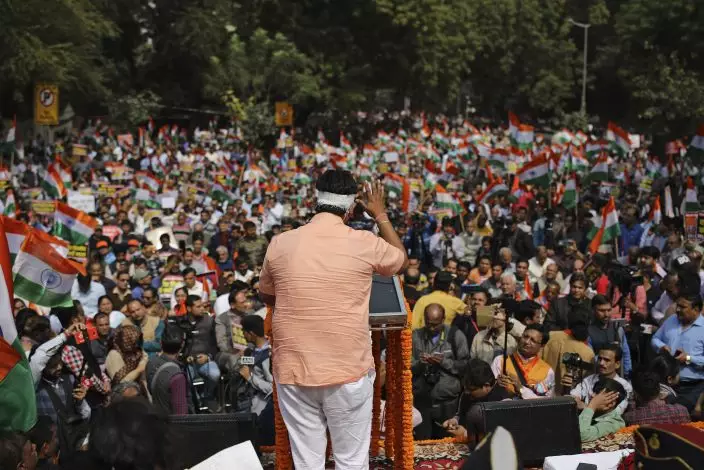
An Indian Hindu man, who was allegedly injured in communal violence, addresses a protest demonstration organized by Hindu organizations in New Delhi that in New Delhi, India, Saturday, Feb. 29, 2020. On the eve of U.S. President Donald Trump’s first state visit to India last Sunday, Hindus and Muslims in the Indian capital charged at each other with homemade guns and crude weapons, leaving the streets where the rioting occurred resembling a war zone, with houses, shops, mosques, schools and vehicles up in flames. More than 40 people were killed and hundreds more wounded. (AP PhotoAltaf Qadri)
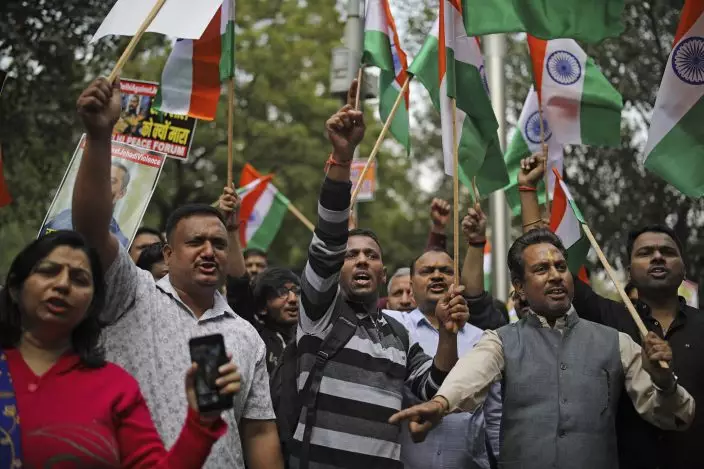
Supporters of a contentious new citizenship law wave Indian national flags and shout religious slogans as they participate in a protest demonstration organized by Hindu organizations in New Delhi that in New Delhi, India, Saturday, Feb. 29, 2020. The law fast-tracks naturalization for some religious minorities from neighboring countries but not Muslims. Opponents say it violates India's secular constitution, and further marginalizes the 200 million Muslims in this Hindu-majority nation of 1.4 billion people. On the eve of U.S. President Donald Trump’s first state visit to India last Sunday, Hindus and Muslims in the Indian capital charged at each other with homemade guns and crude weapons, leaving the streets where the rioting occurred resembling a war zone, with houses, shops, mosques, schools and vehicles up in flames. More than 40 people were killed and hundreds more wounded. (AP PhotoAltaf Qadri)


